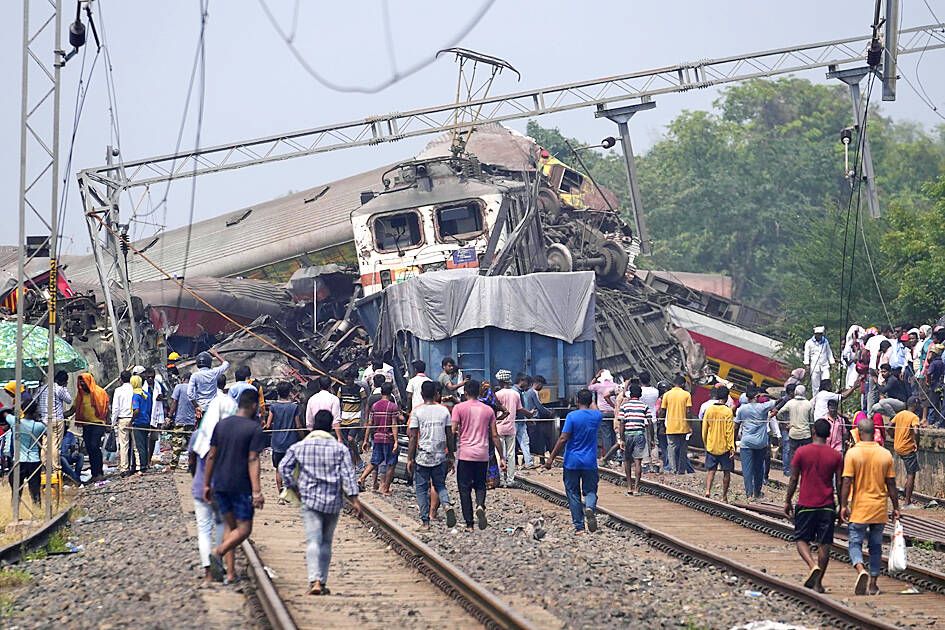At least 288 people were killed and more than 850 injured in a three-train collision in India, officials said yesterday, in what is the country’s deadliest rail incident in more than 20 years.
Images from the crash site near Balasore, in the eastern state of Odisha, showed smashed train compartments torn open with blood-stained holes.
Carriages had flipped over entirely in the crash late on Friday, and rescue workers searched for survivors trapped in the mangled wreckage, with scores of bodies laid out under white sheets beside the tracks.

Photo: AP
As dawn broke yesterday, rescue workers could see the full extent of the carnage.
Odisha Fire Service director-general Sudhanshu Sarangi said that the death toll stood at 288.
“The rescue work is still going on,” he said at the site, adding that there were “a lot of serious injuries.”
India is no stranger to railway incidents, the worst of them in 1981, when a train derailed while crossing a bridge in the state of Bihar and plunged into the river below, killing 800 to 1,000 people.
Friday’s crash is believed to be the worst since the 1990s.
Odisha State Disaster Management Authority Managing Director Pradeep Kumar Jena said that about 850 injured people had been sent to hospitals following the crash, which took place about 200km from the state capital, Bhubaneswar.
“Our top priority now is rescuing [the passengers] and providing health support to the injured,” he said.
Two passenger trains “had an active involvement in the accident,” while “the third train, a goods train, which was parked at the site, also got [involved] in the accident,” Indian Railways executive director Amitabh Sharma said.
One survivor told local television news reporters that he was sleeping when the incident happened, and woke to find himself trapped under about a dozen fellow passengers, before somehow crawling out of the carriage with only injuries to his neck and an arm.
With so many wounded, injured people were carried by ambulances and buses to any hospital that had space.
“All big government and private hospitals from the accident site to the state capital” were prepared to support the injured, Odisha State Disaster Management Authority spokesperson S.K. Panda said.
Authorities had sent “75 ambulances to the site and had also deployed many buses” to transport injured passengers, Panda added.
At Bhadrak District Hospital in Odisha, ambulances brought in injured people, with bloodied and shocked survivors receiving treatment in crowded wards.
Indian Prime Minister Narendra Modi said he was “distressed by the train accident.”
“In this hour of grief, my thoughts are with the bereaved families. May the injured recover soon,” Modi wrote on Twitter, adding that he had spoken to Indian Minister of Railways, Communications and Electronics and Information Technology Ashwini Vaishnaw to take “stock of the situation.”
Vaishnaw said that he was rushing to the site of the crash, with rescue teams including the Indian National Disaster Response Force and the Indian Air Force working frantically.

TRAGEDY STRIKES TAIPEI: The suspect died after falling off a building after he threw smoke grenades into Taipei Main Station and went on a killing spree in Zhongshan A 27-year-old suspect allegedly threw smoke grenades in Taipei Main Station and then proceeded to Zhongshan MRT Station in a random killing spree that resulted in the death of the suspect and two other civilians, and seven injured, including one in critical condition, as of press time last night. The suspect, identified as a man surnamed Chang Wen (張文), allegedly began the attack at Taipei Main Station, the Taipei Fire Department said, adding that it received a report at 5:24pm that smoke grenades had been thrown in the station. One man in his 50s was rushed to hospital after a cardiac arrest

SAFETY FIRST: Double the number of police were deployed at the Taipei Marathon, while other cities released plans to bolster public event safety Authorities across Taiwan have stepped up security measures ahead of Christmas and New Year events, following a knife and smoke bomb attack in Taipei on Friday that left four people dead and 11 injured. In a bid to prevent potential copycat incidents, police deployments have been expanded for large gatherings, transport hubs, and other crowded public spaces, according to official statements from police and city authorities. Taipei Mayor Chiang Wan-an (蔣萬安) said the city has “comprehensively raised security readiness” in crowded areas, increased police deployments with armed officers, and intensified patrols during weekends and nighttime hours. For large-scale events, security checkpoints and explosives

PUBLIC SAFETY: The premier said that security would be tightened in transport hubs, while President Lai commended the public for their bravery The government is to deploy more police, including rapid response units, in crowded public areas to ensure a swift response to any threats, President William Lai (賴清德) said yesterday after a knife attack killed three people and injured 11 in Taipei the previous day. Lai made the remarks following a briefing by the National Police Agency on the progress of the investigation, saying that the attack underscored the importance of cooperation in public security between the central and local governments. The attack unfolded in the early evening on Friday around Taipei Main Station’s M7 exit and later near the Taipei MRT’s Zhongshan

A car bomb killed a senior Russian general in southern Moscow yesterday morning, the latest high-profile army figure to be blown up in a blast that came just hours after Russian and Ukrainian delegates held separate talks in Miami on a plan to end the war. Kyiv has not commented on the incident, but Russian investigators said they were probing whether the blast was “linked” to “Ukrainian special forces.” The attack was similar to other assassinations of generals and pro-war figures that have either been claimed, or are widely believed to have been orchestrated, by Ukraine. Russian Lieutenant General Fanil Sarvarov, 56, head